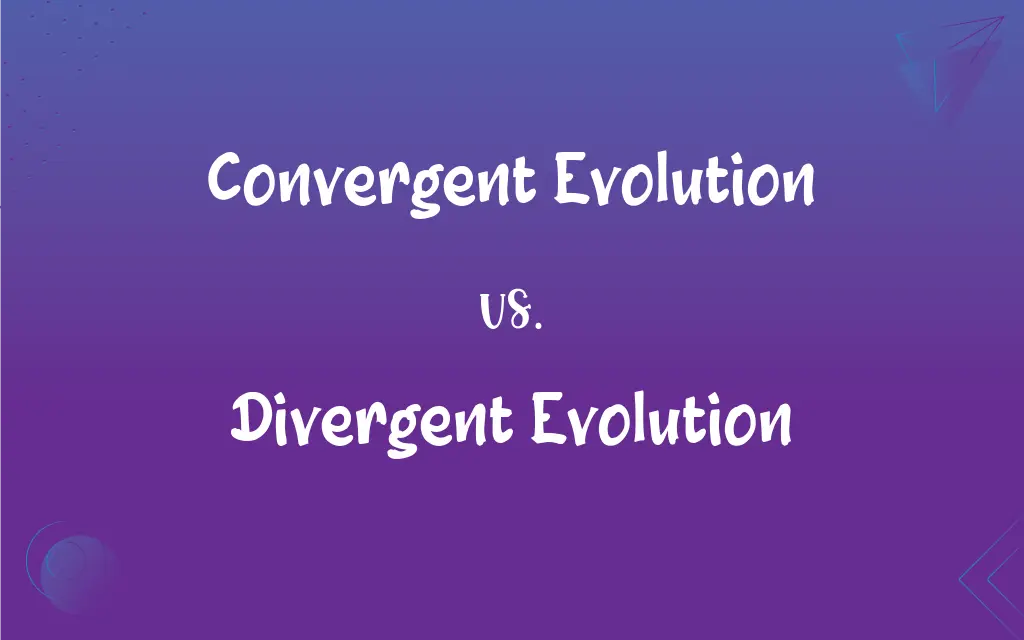Convergent Evolution vs. Divergent Evolution: What's the Difference?
Edited by Aimie Carlson || By Harlon Moss || Updated on October 19, 2023
Convergent evolution describes unrelated organisms developing similar traits due to similar environments, while divergent evolution refers to related species evolving different traits due to different environments or isolation.

Key Differences
Convergent evolution and divergent evolution are two concepts that describe the directionality of evolutionary changes among species. While both deal with changes in species over time, their causes and outcomes are distinctly different.
In convergent evolution, unrelated species evolve similar features or traits because they adapt to similar environments or ecological niches. An example could be the development of wings in bats (mammals) and birds (reptiles). Despite their distant relation, both have wings because they have adapted to flying. In contrast, divergent evolution occurs when a single ancestral species splits into two or more species, evolving different traits due to different environments or reproductive isolation.
Convergent evolution emphasizes the idea that different species can end up looking or behaving similarly because they face similar challenges or opportunities in their respective habitats. On the other hand, divergent evolution focuses on how a single species can branch out into multiple species with different traits over time.
Convergent evolution highlights the power of environmental factors in shaping the evolution of species. When different species are exposed to similar pressures, they may evolve in parallel ways. Meanwhile, divergent evolution often starts with a genetic variation within a species. This variation can lead to speciation, especially when populations of the same species are isolated from one another.
To put it succinctly, while convergent evolution brings separate species to look or act more alike, divergent evolution takes a single species and results in multiple species that differ in traits and characteristics.
ADVERTISEMENT
Comparison Chart
Definition
Unrelated species evolve similar traits.
A single species evolves into multiple species with different traits.
Cause
Similar environmental pressures.
Different environments or reproductive isolation.
Example
Wings in bats and birds.
Darwin's finches with different beak shapes.
Outcome
Different species become more alike.
A single species becomes more diverse.
Relation to Ancestry
Doesn't imply a recent common ancestor.
Implies a common ancestor that diversified.
ADVERTISEMENT
Convergent Evolution and Divergent Evolution Definitions
Convergent Evolution
The independent development of similar features in species of different lineages.
The wings of insects and birds are a result of convergent evolution, evolving independently for flight.
Divergent Evolution
Evolutionary changes that cause species to differ from a common ancestor.
The differences between chimpanzees and humans arose from divergent evolution from a shared ancestor.
Convergent Evolution
The process by which unrelated species evolve similar traits.
Despite their differences, dolphins (mammals) and sharks (fish) exhibit convergent evolution in their streamlined body shapes for efficient swimming.
Divergent Evolution
The process by which a single ancestral species evolves into two or more distinct species.
Divergent evolution caused the diverse range of marsupials in Australia.
Convergent Evolution
Adaptations arising in different organisms in response to analogous environmental challenges.
Convergent evolution is evident in the similar camouflaging patterns of animals from different continents.
Divergent Evolution
The development of different characteristics in species sharing a common ancestry.
The numerous species of cats, from lions to domestic cats, demonstrate divergent evolution from a common feline ancestor.
Convergent Evolution
The phenomenon where different species independently evolve similarities.
The similarities between the Australian marsupial mole and the placental mole in North America are due to convergent evolution.
Divergent Evolution
The evolution of different traits in related species due to different environments or isolation.
Divergent evolution led to various beak shapes among Darwin's finches based on their food sources.
Convergent Evolution
Evolutionary changes leading to similarity in unrelated organisms.
The cactus in North America and the euphorbia in Africa display convergent evolution, having similar appearances due to arid habitats.
Divergent Evolution
The branching out of a single species into multiple species with different characteristics.
The variety of dog breeds today is a result of divergent evolution from a common ancestral wolf species.
FAQs
Can convergent evolution occur in plants?
Yes, like the similar desert adaptations seen in cacti (Americas) and euphorbias (Africa).
How is divergent evolution different from convergent evolution?
Divergent evolution involves a single species evolving into multiple species with different traits, often due to varying environments or isolation.
What is convergent evolution?
It's when unrelated species evolve similar traits due to similar environmental pressures.
Is divergent evolution a result of speciation?
Yes, it often leads to the formation of new species with different traits.
What's a classic example of divergent evolution?
Darwin's finches, where one species diversified into several species with varying beak shapes.
Why does divergent evolution occur?
Due to different environmental pressures, reproductive isolation, or genetic variations.
Are the traits from convergent evolution inherited from a common ancestor?
No, they evolve independently in different lineages.
Does convergent evolution occur only due to similar environments?
Mostly, but other factors like similar ecological roles or challenges can also drive it.
Can human activities influence divergent evolution?
Yes, activities like selective breeding have resulted in divergent evolution in domesticated animals and plants.
Can convergent evolution occur in behavior?
Yes, unrelated species can develop similar behaviors in response to similar challenges or opportunities.
How does geographic isolation contribute to divergent evolution?
It prevents gene flow between populations, allowing them to evolve independently and diverge.
Does convergent evolution imply a close genetic relationship?
No, it involves similar traits in species that aren't necessarily closely related.
Can convergent evolution result in identical species?
Not identical, but they can appear or function very similarly.
Is convergent evolution evidence for evolution?
It's one of many pieces of evidence showing how species adapt to their environments.
How does genetic variation contribute to divergent evolution?
It provides the raw material upon which natural selection acts, leading to different traits in populations.
Can convergent evolution mislead in determining evolutionary relationships?
Yes, similar traits from convergent evolution might be mistakenly interpreted as evidence of close relatedness.
Does divergent evolution always lead to entirely different species?
Over time and under the right conditions, it can lead to speciation.
Why is studying both convergent and divergent evolution important?
They offer insights into the mechanisms and outcomes of evolution, helping understand biodiversity and adaptation.
Are adaptive radiations a type of divergent evolution?
Yes, it's when a single species rapidly diversifies into multiple species, each adapted to a specific niche.
Can convergent evolution lead to species occupying similar niches in different regions?
Yes, similar environmental challenges can lead to species in different regions evolving similar adaptations.
About Author
Written by
Harlon MossHarlon is a seasoned quality moderator and accomplished content writer for Difference Wiki. An alumnus of the prestigious University of California, he earned his degree in Computer Science. Leveraging his academic background, Harlon brings a meticulous and informed perspective to his work, ensuring content accuracy and excellence.
Edited by
Aimie CarlsonAimie Carlson, holding a master's degree in English literature, is a fervent English language enthusiast. She lends her writing talents to Difference Wiki, a prominent website that specializes in comparisons, offering readers insightful analyses that both captivate and inform.































































